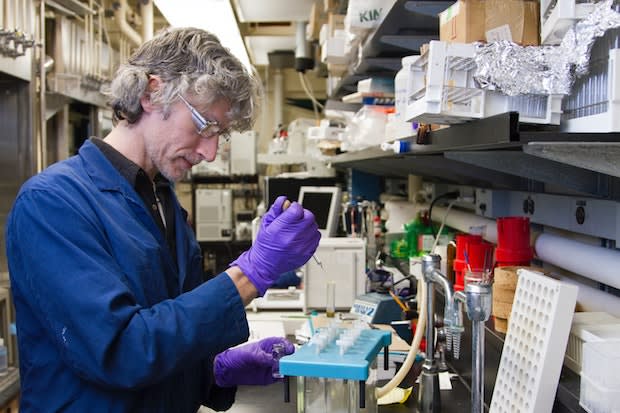Table of Contents
II. How Do I Know If I Need Hormone Replacement Therapy?
III. Diagnosing Hormonal Problems
IV. Types of Hormone Replacement Therapy
What is Estrogen?
Estrogen is an important hormone that is present in both males and females. Both testosterone and estrogen are needed within the human body for sexual and reproductive development. Estrogen is typically referred to as a “female sex hormone,” but it encompasses several similar hormones, like estrone, estradiol, and estriol. Other hormones like progesterone also assist estrogen in stopping ovulation during pregnancy.
Estrogen has a higher concentration in women and is produced mostly in the ovaries and in fat cells and the adrenal gland. When a girl goes through puberty, estrogen develops female secondary sex characteristics, like armpit hair, pubic hair, breasts, and wider hips. Along with these features, it regulates the menstrual cycle and makes reproduction possible. As a woman ages, estrogen also maintains bone health and helps rebuild bones. Estrogen levels start to decline as a woman ages, which results in menopause. If hormone levels decline rapidly, there are several hormone replacement medications available, including Estraderm (estradiol), Climara (estradiol), and Prometrium (progesterone). [1]
a. Hormone Levels Throughout a Woman’s Life
The female body goes through many changes as women age. Read below to learn about the role of hormones in different phases of life.
Puberty: During puberty, estrogen ramps up and is responsible for almost all physical changes. These changes include the maturation of breasts, ovaries, uterus, and vagina. Estrogen also spurs on the first menstrual cycle. It also affects a woman’s mood, so mood swings are also common during this time.
Child-Bearing Years: Once a woman gets her first period, the estrogen levels normalize during child-bearing years. If a woman is not pregnant, estrogen's main role is to increase blood flow to the uterus, enabling successful fetal development if a woman does become pregnant.
During Pregnancy: Hormone levels spike drastically during the first trimester of pregnancy, which is likely responsible for nausea. It also helps develop milk ducts. Once a baby is born, estrogen dips severely, which is thought to be responsible for some postpartum symptoms. Perimenopause & Menopause: Once a woman is over 40 years old, the ovaries continue to produce estrogen but at lower levels. This may bring on perimenopause (pre-menopause) that can last four to ten years. Once a woman hits menopause, estrogen levels are very low. This stops the menstrual cycle, and a woman is no longer able to become pregnant. This stage of life also comes with unpleasant symptoms like hot flashes and vaginal dryness. This is the time of life where hormone replacement therapy typically begins. [2] Hormones are secreted by the endocrine glands and send messages to the organs and tissues through the bloodstream. Hormones regulate everything, so it is essential to make sure they are balanced correctly. If estrogen and progesterone are not in balance, you may notice changes in your sleep patterns, metabolism, hunger, and other bodily needs. Of course, changes in sleep patterns and eating habits may not be the sole result of hormone changes, but it is essential to pay attention to your body changes. If you notice a big change to your everyday function, you may want to consult your doctor. Symptoms of a hormone imbalance can include: In the case of women, an imbalance of hormones may present symptoms that are hard to ignore. Child-bearing women may experience infrequent or irregular menstrual periods, signifying an imbalance in estrogen or progesterone. Older women may feel menopausal symptoms when their estrogen levels decline. Unfortunately, there is no specific test to diagnose a hormonal imbalance. It is important to be open and honest with your healthcare provider and make a comprehensive list of your symptoms. A doctor may also need to perform a physical exam, like a pelvic exam, to check for unusual lumps, cysts, or tumors. Blood tests will help detect the lack of hormones in the blood. A blood test will also check your thyroid, estrogen, testosterone, and cortisol levels. It is also important to tell your doctor about any medications, vitamins, or supplements you are taking. There are also tests at home you can perform at home, called follicle-stimulating hormone (FSH). These tests measure FSH levels and a higher FSH level when you enter menopause. These kits may have to be sent off to a lab for proper reading. The point of hormone replacement therapy is to replenish hormones in the body. The two types of estrogen therapy include: Systemic hormone therapy: This type of systemic estrogen therapy contains a higher dose of estrogen circulates throughout the entire body. Systemic estrogen is available in pill, skin, patch, ring, gel, cream, or spray form. Low-dose vaginal products: These products have a lower dose of estrogen and minimize the amount of hormone absorbed by the body. These products are typically available in tablet, ring, or cream form. Because they are lower doses, they are usually only used for vaginal and urinary symptoms of menopause. Some common hormone replacement products include Estraderm (estradiol), Climara (estradiol), and Prometrium (progesterone) Estraderm and Climara contain estradiol, a female hormone that helps symptoms of menopause, like hot flashes and vaginal dryness. Estraderm and Climara are available in a transdermal patch applied to the body. These systemic hormone patches can be replaced twice a week and replaced on a different body part. The content provided in this article is based on thorough research and in some cases, reviewed by a medical professional. Our goal for the information is to provide helpful, general health informational. It is not intended as a substitute for professional medical advice.
How Do I Know If I Need Hormone Replacement Therapy?

Diagnosing Hormonal Problems

Types of Hormone Replacement Therapy
